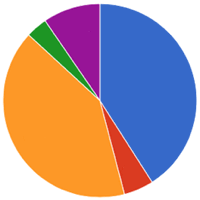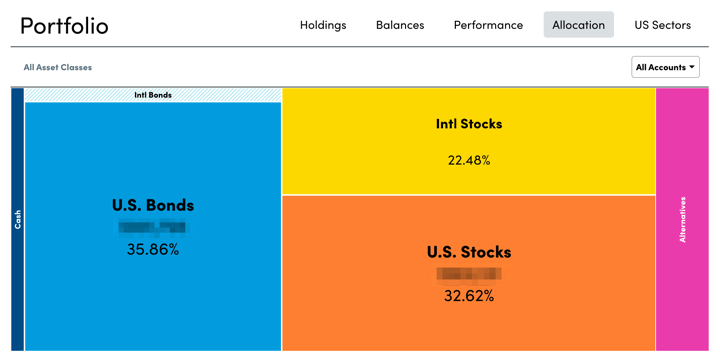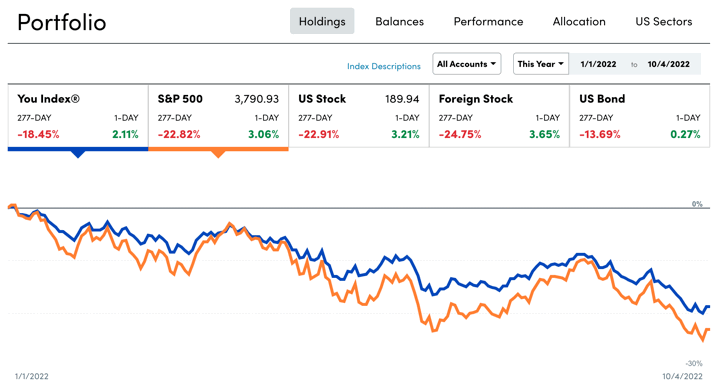MMB Humble Portfolio 2022 3rd Quarter Update: Asset Allocation & Performance
 Here’s my quarterly update on my current investment holdings as of 10/4/22, including our 401k/403b/IRAs and taxable brokerage accounts but excluding real estate and side portfolio of self-directed investments. Following the concept of skin in the game, the following is not a recommendation, but just to share our real, imperfect, low-cost, diversified DIY portfolio. The goal of this “Humble Portfolio” is to create sustainable income that keeps up with inflation to cover our household expenses.
Here’s my quarterly update on my current investment holdings as of 10/4/22, including our 401k/403b/IRAs and taxable brokerage accounts but excluding real estate and side portfolio of self-directed investments. Following the concept of skin in the game, the following is not a recommendation, but just to share our real, imperfect, low-cost, diversified DIY portfolio. The goal of this “Humble Portfolio” is to create sustainable income that keeps up with inflation to cover our household expenses.
“Never ask anyone for their opinion, forecast, or recommendation. Just ask them what they have in their portfolio.” – Nassim Taleb
How I Track My Portfolio
I’m often asked how I track my portfolio across multiple brokers and account types. There are limited free options nowadays as Morningstar recently discontinued free access to their portfolio tracker. I use both Personal Capital and a custom Google Spreadsheet to track my investment holdings:
- The Personal Capital financial tools and real-time tracking (free, my review) automatically logs into my different accounts, adds up my various balances, tracks my performance, and calculates my overall asset allocation daily.
- Once a quarter, I also update my manual Google Spreadsheet (free, instructions) because it helps me calculate how much I need in each asset class to rebalance back towards my target asset allocation. I also create a new tab each quarter, so I have snapshot of my holdings dating back many years.
October 2022 Asset Allocation and YTD Performance
Here are updated performance and asset allocation charts, per the “Allocation” and “Holdings” tabs of my Personal Capital account.


Target Asset Allocation. I call this my “Humble Portfolio” because it accepts the repeated findings that individuals cannot reliably time the market, and that persistence in above-average stock-picking and/or sector-picking is exceedingly rare. Costs matter and nearly everyone who sells outperformance, for some reason keeps charging even if they provide zero outperformance! By paying minimal costs including management fees and tax drag, you can actually guarantee yourself above-average net performance over time.
I own broad, low-cost exposure to productive assets that will provide long-term returns above inflation, distribute income via dividends and interest, and finally offer some historical tendencies to balance each other out. I have faith in the long-term benefit of owning publicly-traded US and international shares of businesses, as well as the stability of high-quality US Treasury and municipal debt. My stock holdings roughly follow the total world market cap breakdown at roughly 60% US and 40% ex-US. I add just a little “spice” to the vanilla funds with the inclusion of “small value” ETFs for US, Developed International, and Emerging Markets stocks as well as additional real estate exposure through US REITs.
I strongly believe in the importance of knowing WHY you own something. Every asset class will eventually have a low period, and you must have strong faith during these periods to truly make your money. You have to keep owning and buying more stocks through the stock market crashes. You have to maintain and even buy more rental properties during a housing crunch, etc. A good sign is that if prices drop, you’ll want to buy more of that asset instead of less. I don’t have strong faith in the long-term results of commodities, gold, or bitcoin – so I don’t own them.
I do not spend a lot of time backtesting various model portfolios, as I don’t think picking through the details of the recent past will necessarily create superior future returns. Usually, whatever model portfolio is popular in the moment just happens to hold the asset class that has been the hottest recently as well.
Find productive assets that you believe in and understand, and just keep buying them through the ups and downs. Mine may be different than yours.
I have settled into a long-term target ratio of roughly 70% stocks and 30% bonds (or 2:1 ratio) within our investment strategy of buy, hold, and occasionally rebalance. This is more conservative than most people my age, but I am settling into a more “perpetual income portfolio” as opposed to the more common “build up a big stash and hope it lasts until I die” portfolio. My target withdrawal rate is 3% or less. Here is a round-number breakdown of my target portfolio.
- 30% US Total Market
- 5% US Small-Cap Value
- 20% International Total Market
- 5% International Small-Cap Value
- 10% US Real Estate (REIT)
- 20% US Treasury Nominal Bonds or FDIC-insured deposits
- 10% US Treasury Inflation-Protected Bonds (or I Savings Bonds)
Commentary. According to Personal Capital, my portfolio down about 18% for 2022 YTD. My US and International stocks have dropped again (even more than the bonds, which also dropped) and so available cashflow is being placed into buying more of those asset classes.
During this last quarter, I sold all of my municipal bonds and bought US Treasuries instead. Due to the rising rates, I had no capital gains to worry about. When I previously cycled into muni bonds, munis were yielding 24% more than Treasuries even before accounting for the tax benefits. In September 2015, I compared the 1.78% SEC yield of Vanguard Intermediate-Term Tax-Exempt Investor Shares (VWITX) to the 1.48% SEC yield of Vanguard Intermediate-Term Treasury Investor Shares (VFITX). The ratio was 1.24. As of October 2022, the ratio is now 0.93 (3.26% vs. 3.51%). At those levels, I am getting compensated much less for the additional risk of municipal finances. My bond portfolio is now US Treasury bonds, bank/credit union CDs (bought if/when the rates exceed US Treasuries), TIPS, and savings I bonds. Can’t get higher quality than that.
I take solace that for now I see more shrinking P/E ratios as opposed to crashing earnings on the stocks side, my REITs are yielding more, and my bonds are yielding more. One good thing about more “normal” interest rates if they can hold is that it gives conservative (often older) savers a chance to keep their principal safe and still earn a small bit of income without market volatility. My primary fear remains that of war.
I’ll share about more about the income aspect in a separate post.


No comments